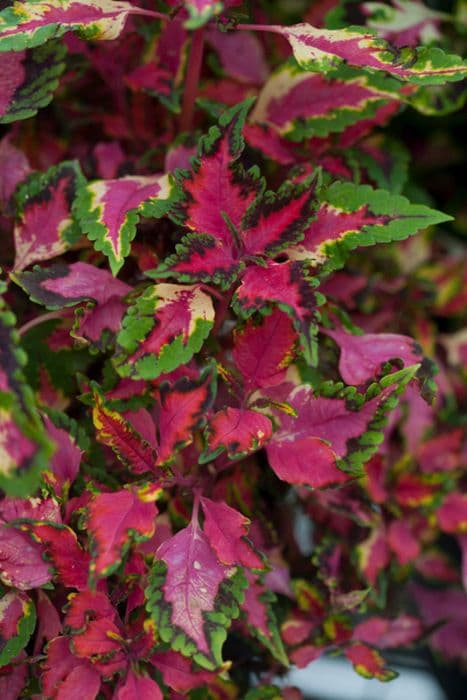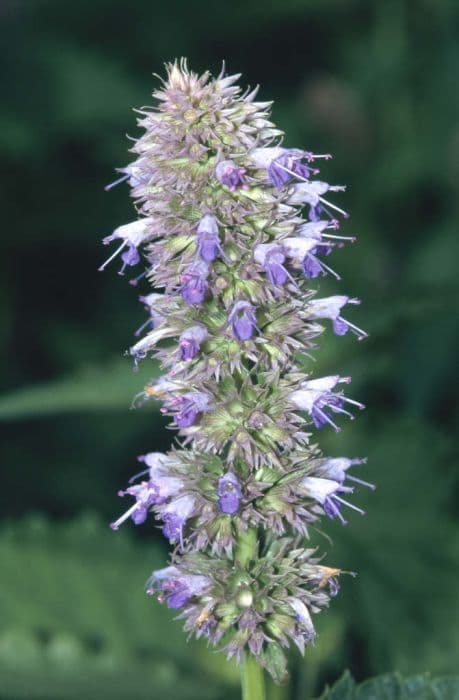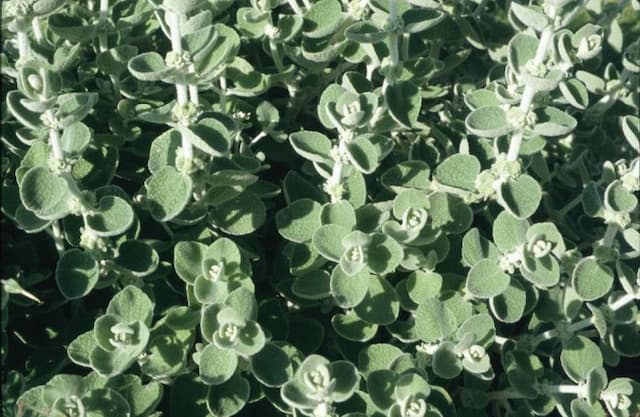Coleus Solenostemon scutellarioides 'Winsome' (v)

ABOUT
The plant in question is commonly known as 'Winsome' Coleus. It is a vibrant and eye-catching ornamental plant, known for its striking foliage. The leaves are the most distinctive feature of this plant, showcasing a rich tapestry of colors. Each leaf is splashed with shades of green, burgundy, and deep purple, often edged in a lime or bright green hue which creates a stark contrast. The leaves are also marked with intricate patterns that can resemble brush strokes, giving each one a unique appearance. They are broad and come to a pointed tip, with a slightly scalloped or wavy edge, which adds to the overall lush and textured look of the plant. The blend of colors on the foliage makes it a standout in any garden or as a container plant. The leaves grow densely, giving the plant a full and bushy appearance, and they can have a velvety texture that's pleasant to the touch.
About this plant
 Names
NamesFamily
Lamiaceae
Synonyms
Coleus, Painted Nettle
Common names
Coleus blumei, Coleus blumei var. verschaffeltii, Coleus hybridus, Coleus scutellarioides, Plectranthus scutellarioides.
 Toxicity
ToxicityTo humans
The Solenostemon scutellarioides 'Winsome', more commonly known as Coleus, is generally considered non-toxic to humans. It is not known for being poisonous, and there are no significant symptoms associated with ingesting parts of this plant. However, as with any plant, individual sensitivity can vary, and some people may experience mild digestive upset if they consume parts of a Coleus.
To pets
The Coleus is generally considered non-toxic to pets. It is not known to be poisonous to dogs, cats, or other domestic animals, and there are no significant symptoms directly associated with the ingestion of this plant. However, some pets may experience mild gastrointestinal distress, such as vomiting or diarrhea if they ingest large quantities of the plant, due to the irritation of the stomach or intestines rather than toxicity.
 Characteristics
CharacteristicsLife cycle
Perennials
Foliage type
Evergreen
Color of leaves
Variegated
Height
1-3 feet (0.3-0.9 meters)
Spread
1-2 feet (0.3-0.6 meters)
Plant type
Herb
Hardiness zones
10
Native area
Southeast Asia
Benefits
 General Benefits
General Benefits- Aesthetic Appeal: Solenostemon scutellarioides 'Winsome', commonly known as Coleus, is prized for its vibrant, multicolored foliage that adds a stunning visual interest to gardens, patios, and indoor spaces.
- Ease of Care: Coleus is known for being a low-maintenance plant, making it suitable for gardeners of all skill levels.
- Versatility: This plant is adaptable to various growing conditions, from full sun to shade, and can be grown in containers, hanging baskets, or beddings.
- Propagation: Coleus is easy to propagate from cuttings, allowing gardeners to quickly expand their collection or share with friends.
- Season-Long Color: Unlike plants that bloom for a short time, Coleus offers season-long color through its foliage, even in the absence of flowers.
 Medical Properties
Medical PropertiesThis plant is not used for medical purposes.
 Air-purifying Qualities
Air-purifying QualitiesThis plant is not specifically known for air purifying qualities.
 Other Uses
Other Uses- Coleus 'Winsome' leaves can be used as a natural dye for fabrics and crafts, imparting a range of colors when treated properly.
- As part of a sensory garden, the texture and colorful foliage of Coleus stimulate the senses and can be beneficial for educational purposes.
- Due to its unique color patterns, Coleus can be pressed and used to create botanical art or herbarium specimens for scientific or decorative purposes.
- The fast-growing nature of Coleus makes it suitable for temporary ground cover in garden displays or events, where quick establishment is needed.
- When grown in a container, Coleus can be used as a mobile element in garden design, allowing for flexible layout changes.
- As an edible garnish, certain parts of the Coleus plant (though not widely recognized for culinary use) could add visual flair to dishes.
- Garden educators may use Coleus to teach principles of propagation, as they root easily from cuttings and can demonstrate plant growth processes.
- The plant can be used in crafting natural insect repellents, leveraging the intense scent of its leaves to deter certain pests.
- In the practice of ikebana (Japanese flower arranging), Coleus provides a bold contrast of color and shape, contributing to the art's aesthetic.
- Coleus can be included in pet-friendly garden areas as an attractive, non-toxic plant choice for pet owners.
Interesting Facts
 Feng Shui
Feng ShuiColeus 'Winsome' can be used in Feng Shui practice to bring in vibrant energy due to its brightly colored leaves. Position it in the wealth corner of a room, traditionally the southeast, to attract prosperity. Its wood element also supports growth and vitality, making it suitable for the east sector of a space to promote health.
 Zodiac Sign Compitability
Zodiac Sign CompitabilityThe Coleus 'Winsome' is not used in astrology practice.
 Plant Symbolism
Plant Symbolism- Versatility and Flexibility: As 'Winsome' is a variety of Coleus, which is known for its ability to adapt to both indoor and outdoor environments, it symbolizes adaptability to life's situations.
- Expressive Beauty: Coleus plants are highly valued for their stunning, colorful foliage, which comes in a variety of shapes and sizes, representing the beauty of expressing one’s true colors.
- Sensory Stimulation: With its bright colors and sometimes textured leaves, Coleus like 'Winsome' symbolizes the idea of stimulating the senses and encouraging an appreciation for the richness of sensory experiences.
- Creativity: The diversity in leaf patterns and colors can symbolize creativity, inspiring individuals to embrace their unique creative spirit.
- Transformation: Coleus plants can change color intensity based on light exposure, representing the theme of transformation and adaptability in life.
 Water
WaterColeus 'Winsome' requires consistent moisture, but avoid waterlogging. Water deeply when the top inch of the soil feels dry, approximately every one to two weeks, depending on the environment. Use lukewarm water and aim for about one-half to one gallon of water per plant, per watering session, ensuring even distribution across the soil without splashing the foliage. During the growing season in spring and summer, increase frequency as necessary due to higher temperatures and light levels, but reduce watering in the cooler, less active growth months of fall and winter.
 Light
LightColeus 'Winsome' thrives in bright, indirect light. It's best to place the plant in a location where it can receive plenty of light without being exposed to direct sunlight, which could scorch the leaves. An east- or north-facing window is ideal, or a shaded south- or west-facing window if there is protection from the direct rays of the sun.
 Temperature
TemperatureColeus 'Winsome' prefers a temperature range between 60 and 75 degrees Fahrenheit, and should not be exposed to temperatures below 50 degrees Fahrenheit, as it is sensitive to cold. The ideal temperature for this plant's growth is within the warmer part of the range, as it originates from tropical regions.
 Pruning
PruningPruning Coleus 'Winsome' is important for maintaining shape and encouraging bushier growth. Pinch back the tips of the stems regularly, especially during the growing season, to promote branching. Pruning can be done every two to three weeks or as needed to maintain the desired size and shape. The best time to prune heavily is in the spring or early summer before new growth begins.
 Cleaning
CleaningAs needed
 Soil
SoilColeus 'Winsome' thrives in a well-draining, nutrient-rich potting mix with a pH range of 6.0 to 7.0. A mixture of peat, perlite, and compost is ideal to ensure proper aeration and moisture retention.
 Repotting
RepottingColeus 'Winsome' should be repotted annually to replenish nutrients and provide room for growth, preferably in the spring or early summer when the plant is actively growing.
 Humidity & Misting
Humidity & MistingColeus 'Winsome' prefers high humidity levels, ideally between 40-70%, to maintain its vibrant foliage and overall health.
 Suitable locations
Suitable locationsIndoor
Provide bright indirect light, warm temperature, and high humidity for Coleus.
Outdoor
Plant Coleus in partial shade, protect from strong winds, and keep soil moist.
Hardiness zone
10-11 USDA.
 Life cycle
Life cycleColeus 'Winsome' begins its life as a seed, where after germination it sprouts into a small seedling with a pair of initial leaves. As it enters the vegetative stage, the seedling develops true leaves with the characteristic vibrant patterning and begins to establish a stronger root system. During its growth period, the coleus requires warm temperatures, ample light, and consistent moisture to thrive and reach maturity. When mature, the coleus 'Winsome' may produce small flowers on spikes if not regularly pinched back, although the flowers are generally considered less desirable than the foliage. If the flowers are allowed to set and generate seeds, these can be collected for propagation, although many cultivars are more commonly propagated via stem cuttings to retain their variegated traits. After flowering, the annual coleus plant completes its life cycle and will die with the onset of cold temperatures unless it is protected or moved indoors.
 Propogation
PropogationPropogation time
Spring-Summer
The Solenostemon scutellarioides 'Winsome', commonly known as Coleus 'Winsome', is often propagated during the warm seasons of spring and summer when the plant is actively growing. The most popular method of propagation for this ornamental is through stem cuttings. To do this, a healthy, non-flowering stem tip around 4 to 6 inches (10 to 15 centimeters) long is cut just below a leaf node. The lower leaves are removed, and the cutting is dipped in rooting hormone to encourage root growth. The prepared cutting is then placed in a moist potting mix or water. If using soil, the pot is covered with plastic to maintain humidity until roots develop, which usually takes about 2 to 3 weeks. After roots have formed, the new Coleus plant can be transplanted to a permanent location where it will continue to grow and add vibrant color to the garden or home.









